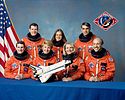STS-40
| Missionsemblem | |||||
|---|---|---|---|---|---|
 | |||||
| Missionsstatistik | |||||
| Missionsnavn: | STS-40 | ||||
| Rumagentur: | NASA | ||||
| Rumfartøjets navn: | Columbia (11) | ||||
| Antal besætningsmedlemmer: | 7 | ||||
| Affyringsrampe: | 39A KSC | ||||
| Opsendelse: | 5. juni 1991 | ||||
| Landing: | 14. juni 1991 | ||||
| Landet på: | Edwards Air Force Base | ||||
| Varighed: | 9 dage | ||||
| Foto af besætningen | |||||
 | |||||
| Navigation | |||||
| |||||
STS-40 var Columbias 11. rumfærge-mission. Opsendt 5. juni 1991 og vendte tilbage den 14. juni 1991. Det var en spacelabmission kaldet SLS-1 (Spacelab Life Sciences) og var fokuseret på biologi.
Besætning

 Bryan O'Connor (kaptajn)
Bryan O'Connor (kaptajn)
 Sidney Gutierrez (pilot)
Sidney Gutierrez (pilot)
 James Bagian (1. missionsspecialist)
James Bagian (1. missionsspecialist)
 Tamara Jernigan (2. missionsspecialist)
Tamara Jernigan (2. missionsspecialist)
 Margaret Seddon (3. missionsspecialist)
Margaret Seddon (3. missionsspecialist)
 Francis Gaffney (1. nyttelastspecialist)
Francis Gaffney (1. nyttelastspecialist)
 Millie Hughes-Fulford (2. nyttelastspecialist)
Millie Hughes-Fulford (2. nyttelastspecialist)
Missionen
Hovedartikler:
Eksterne henvisninger
- STS-40 NASA (engelsk)
| ||||||||
Medier brugt på denne side
Forfatter/Opretter: By Rei-artur (diskussion · bidrag)., Licens: CC-BY-SA-3.0
Venus/female symbol.
STS-40 Mission Insignia
The STS-40 crew portrait includes 7 astronauts. Pictured on the front row from left to right are F. Drew Gaffney, payload specialist 1; Milli-Hughes Fulford, payload specialist 2; M. Rhea Seddon, mission specialist 3; and James P. Bagian, mission specialist 1. Standing in the rear, left to right, are Bryan D. O'Connor, commander; Tamara E. Jernigan, mission specialist 2; and Sidney M. Gutierrez, pilot. Launched aboard the Space Shuttle Columbia on June 5, 1991 at 9:24; am (EDT), the STS-40 mission was the fifth dedicated Spacelab Mission, Spacelab Life Sciences-1 (SLS-1), and the first mission dedicated solely to life sciences.
This scene represents the end of NASA's STS-1 mission and the beginning of STS-2 in that the orbiter Columbia is arriving at Kennedy Space Center in Florida to begin the lengthy process of preparing it for STS-2. The vehicle landed at Dryden Flight Research Center on April 14 after an historic 2 1/3 day flight in Earth orbit. It was mated to this 747 aircraft, titled NASA 905, and flown over the USA to its Florida destination. It was later removed from atop NASA 905 and moved to the orbiter processing facility for the beginning of refurbishment.
Forfatter/Opretter: Rei-artur (diskussion · bidrag), reshaped by F l a n k e r (talk), Licens: CC-BY-SA-3.0
symbol of Mars. 400 × 400 pixels nominal dimensions, line 45 pixel tick, circle 295 × 295 pixel, not joined with arrow. Colour: red=0 green=0 blue=140.
![]() Vektorgrafikken blev lavet med Inkscape.
Vektorgrafikken blev lavet med Inkscape.






